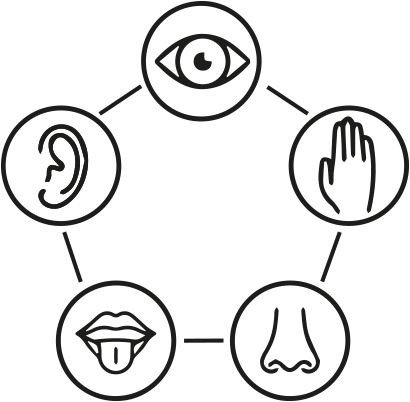| Who Nose? A workshop on smell and 21st Century Learning
V2
By Anna Harris
Maastricht University |
Intended learning outcomes (more on programme level)
- Assess the validity of sources of information and organize information in a well-reasoned argument by using your senses and sensory data collecting techniques
- Approach a 21st century learning issue with an open, curious and critical attitude, paying particular attention to sustainability and intercultural sensitivities by considering the transferability and impact of sensory skills
- Design / ideate an intervention or problem solution using your senses to trigger creative responses
- Gather, use and give feedback by communicating more efficiently and clearly around the senses.
- Develop a life-long learning attitude, maintaining an open, curious and critical attitude by learning technique to train your senses on an ongoing basis and use your body as a research instrument.
|
| Learning objectives (course specific)
How smell as a research tool and could inform investigation, specifically to think about how smell might: be important:
- During the research phase (as a tool to take other people’s perspective, to come up with new questions for the Challenge Owner and other stakeholders involved);
- For analytical purposes to think through their challenges more conceptually;
- And also as a potential factor for the interventions that they will come up with further along their trajectory.
|
| Objective statement (course description)
Smell has long been part of education. Doctors for example would learn how to smell urine samples and diagnose based on the smell, sight and (yes) taste of the urine. A wine taster needs to learn how to tell the differences between types of wine and to describe the bouquet of the wine, and a perfume maker needs to train their ‘nose’ too. Histories of smell show the importance of odour in understanding issues of class, hygiene and sanitation. Smell has however been a more neglected sense in education and research more broadly, despite its strong links to emotion and memory. In these workshops, you will train your sense of smell and consider how sensing in a different way might help you to address the issues of your challenge owner and the challenge they pose. How might a sensitivity to smell help you address the challenge? How might you use smell to inform your investigation, and maybe even make it part of the intervention? |
| Type of course
Skills course |
| Target group
University students |
| Teaching method
Workshop |
| Activities
Tutorial 1
Part I
- Introductions – in pairs, discuss a strong smell memory from “home” (whatever that means to you), and share this with the group
- Smell kit exercise – a commercial smell kit is passed around and we will describe the smells
- Anna will introduce some different research on smell, from interdisciplinary perspective, including her own research in medicine education as well as examples from other fields (e.g. marketing), as a way to lead discussion
- Short break
Part II
- We will then brainstorm what it might mean to make a smell kit relevant to your challenge owner and challenge. Each presents their challenge, while this student presents, the others jot down questions and smell impression on post-its and share afterwards. Encourage students to identify areas that they would appreciate feedback on. Then as a group they brainstorm together using the following questions as prompts:
– What might attention to smell open up?
– How might smell open up questions about the material things that they challenges are made of?
– What kinds of smells would elicit some of these questions/solutions?
– How might you go beyond discussion of how smell features in their projects to thinking critically about this together?
– What are the histories of some of the smells (we can use tools in class such as the Odeuropa Smell Explorer to explore this: https://explorer.odeuropa.eu/)
– How smell is relevant at different times in their project, or for different people?
Between tutorials collect materials to bring to the next class to make a smell kit. These may be literal or representative connections to the challenge. Students are encouraged not only think about smell in a literal sense but how it connects to theory.
Tutorial 2 – Making a smell kit*
Part I
- We head out to the FASoS garden (weather permitting) and see if there are any more materials to collect. We walk in pairs, reflecting with each other on the materials we’ve brought to the session.
- We form as a group and share what we would put into our kits and why. Questions for each other.
- Anna will introduce some different interventions using smell, public health to museums, as a way to lead discussion on the possibilities of how smell might be used with their challenge owners.
Part II
- Everyone assembles their kits.
- Make a small explanatory text accompanying the kit (form open to your creativity), explaining why the smells were chosen and how to use the kit.
- Group discussion on how the kit/smells may be brought into your group’s challenge.
*students may also want to make a smell map instead, see https://sensorymaps.com/ |
| Assessment of learning
The following questions are posed to the students that they need to answer on 4 different occasions: before the first tutorial, after the first tutorial, before the second tutorial, and after the second tutorial.
- How would you self-rate your own personal skills in smelling, from 1 (not very good) to 5 (excellent)? In one sentence, why?
- List as many examples as you can think of in five minutes for how you use smell in your academic work?
- How do you imagine that smell might be relevant to your group’s project?
- Free text box thoughts on course so far (could include content, organization, teacher, group, how it fits in the bigger program)
|
| Additional biblio sources |
